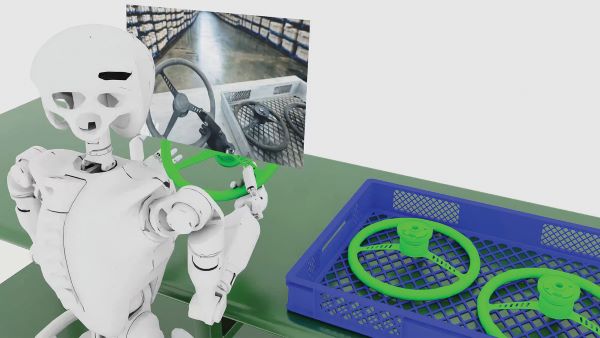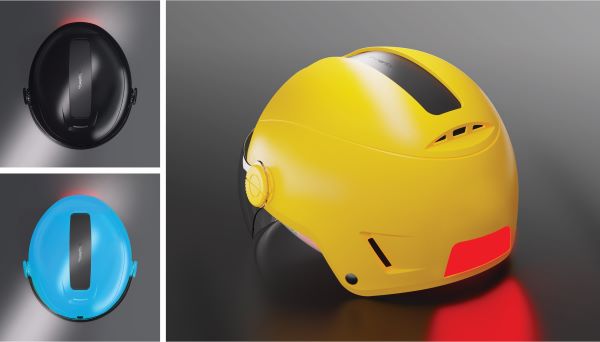With over 135,000 attendees and 4,000 exhibitors, visitors were able to see and discuss innovations across autonomous driving, AI, networks and communications, smart homes and everything that could be defined as being ‘smart’.
The technology market for 2025 is looking healthy according to the Tech Trends Forecast report, which was published just before CES started. Commissioned by the Consumer Technology Association (CTA), the organisers of CES, it suggested retail revenue was projected to reach $537 billion in 2025, an increase from $520 billion in 2024.
The report highlighted the growth of artificial intelligence in all aspects of technology and commenting prior to CES Ben Wood, Chief Analyst, CCS Insight said that while artificial intelligence would undoubtedly be an omnipresent theme of all the major keynotes and press conferences, “We are reaching a point where AI is now just an expected talking point rather than a real major story.”
True, but NVIDIA’s founder and CEO Jensen Huang might have disagreed with that take as he kicked off CES 2025 with a keynote that included the unveiling of new products to advance gaming, autonomous vehicles, robotics, and agentic AI.
According to Huang, AI has been “advancing at an incredible pace, having started with perception AI - understanding images, words, and sounds. Then generative AI - creating text, images and sound.” He went on to argue that we are now entering the era of “physical AI, AI that can proceed, reason, plan and act.”
Huang’s keynote covered several significant announcements, including the Cosmos platform, which has been developed to advance physical AI with new models and video data processing pipelines for robots, autonomous vehicles and vision AI, while the NVIDIA Blackwell-based GeForce RTX 50 Series GPUs, that were unveiled to a rapt audience of over 6000, offers significantly improved visual realism and unprecedented performance boosts.

Above: Nvidia's Jensen Huang presented the company's Cosmos platform during his keynote address
Huang described the Cosmos world foundation model platform as a game-changer for robotics and industrial AI. “The ChatGPT moment for general robotics is just around the corner,” he suggested.
Cosmos integrates generative models, tokenizers, and a video processing pipeline to power physical AI systems like AVs and robots, enabling them to simulate every possible future and select optimal actions. Cosmos models ingest text, image or video prompts and generate virtual world states as videos.
“Cosmos generations prioritise the unique requirements of AV and robotics use cases like real-world environments, lighting and object permanence,” explained Huang who added that a number of leading robotics and automotive companies have been among the first to adopt it.
Huang suggested that NVIDIA’s innovations were helping to pave the way for AI to revolutionise the physical world with robotics. “All of the enabling technologies that I’ve been talking about are going to make it possible for us in the next several years to see very rapid breakthroughs, surprising breakthroughs, in general robotics.”
Growing personalisation
At Samsung Electronics’ press conference JH Han, Vice Chairman, CEO and Head of Samsung’s DX Division talked about the company’s new ‘AI for All’ vision, with the focus being to make AI an ‘everyday, everywhere’ experience.
Central to this is Samsung’s roadmap for Home AI, in which it intends to provide personalised services across all intelligent, connected devices. This strategy, alongside Samsung’s innovations in AI-powered devices aims to bring ‘the power of AI’ to everyday experience, according to Han, who explained that the company’s Home AI vision was one in which AI would learn from habits and adapt to individual routines to deliver a hyper-personalised smart home experience.
Security and privacy were also at the heart of Samsung’s strategy for Home AI especially as more connected devices are used and brought into the home and AI becomes more personal - it will also need to protect users’ privacy.
Consequently, Samsung Knox Matrix has been developed to protect home appliances along with mobile devices and TVs using blockchain technology to ensure that connected devices are working together to protect the user’s home, data and each other from digital threats.
As information syncs across devices, Knox Matrix’s Credential Sync ensures that data can only be encrypted or decrypted from the user’s devices, and Samsung Knox Vault adds another layer of protection, keeping sensitive information like passwords or PINs isolated in a secure location.
Samsung’s smart home platform looks to bring intelligent connectivity to millions of users and SmartThings is being equipped with the latest AI technology to streamline and personalise the smart home experience. SmartThings’ Ambient Sensing intuitively understands the user’s environment and situational context by analysing human movements and even ambient sounds within the home, enabling devices to intelligently respond and adapt to daily routines.
Bixby Voice, which is an enhanced AI voice assistant, is also set to be integrated to increase usability and has been trained to recognise individual voices and respond to commands in a way that works best for each user.
Much like NVIDIA, Samsung’s AI innovations are looking to transform new categories and industries, and SmartThings Pro has been created to bring the same AI-powered digital solutions to business partners as SmartThings offers consumers. SmartThings Pro is a B2B solution spanning multi-residential homes to retail spaces, hotels, schools and more. The platform, which was released last year, enables users to monitor energy usage, identify devices with maintenance needs and offer comprehensive control of connected solutions.
Ambient intelligence
Ambient intelligence is the concept of capturing and processing data through sensors, processors, and actuators unobtrusively embedded throughout the environment and at CES Dutch spin-out Innatera demonstrated a new Spiking Neural Processor (SNP) that it claimed would transform the way battery-powered devices make sense of the physical world.
“This Spiking Neural Processor delivers brain-inspired cognition for sensors, unlocking the promise of ambient intelligence,” said Sumeet Kumar, CEO of Innatera. “This is a revolutionary processor that simplifies and optimises sensor data processing at the edge.”
This device combines a Spiking Neural Network (SNN) engine with a RISC-V processor core and other accelerators to bring intelligence closer to sensors, enabling next-generation AI and signal processing for applications in consumer electronics, such as audio interfaces and touch-free interfaces.
For many, ambient Intelligence will be a major departure from computing technology as we currently know it and it will help to pave the way for a future where digital interactions are as natural as breathing, according to Kumar.
At CES, Innatera demonstrated how audio scene classification will allow devices to be aware of the environment they operate in and use this information to adapt their operation. For example, in noise cancelling headphones, this might mean adapting to the ambient noise profile of an airplane or a bus.
Automotive tech
Alongside the news that NXP Semiconductors was set to acquire TTTech Auto and Renesas Electronics had signed an agreement with Honda to develop an SoC for software defined technology, Intel unveiled an expanded product portfolio and new partnerships intended to accelerate the automotive industry’s transition to electric and software-defined vehicles (SDVs).
Intel is offering a whole-vehicle platform, including high-performance compute, discrete graphics, AI, power management and zonal controller solutions alongside the Intel Automotive Virtual Development Environment (VDE) co-developed with Amazon Web Services (AWS).
“Our whole-vehicle approach, combined with cloud integration, delivers a complete solution that drives down total cost of development and deployment while empowering automakers to build the future of mobility faster, more efficiently and more profitably,” said Jack Weast, Intel Fellow, vice president and general manager of Intel Automotive.
Harman, a Samsung subsidiary, presented new technology that it said would develop tech that would create a ‘unique environment’ for the driver through what was described as an ‘emotionally intelligent AI system’ which features an avatar, called Luna, which is integrated with a voice assistant platform.
According to Harman Luna will add to the functionality of its other AI solutions and personalise interactions through a friendly voice and visuals - helping to foster a natural bond between vehicle occupants and the tech.
Luna will be integrated with Harman’s Ready Vision products, such as the QVUE windshield display, that delivers immersive augmented reality features such as dynamic street visualisation and transparent hood views.
Weird and wonderful
As always with CES there were a host of new consumer devices – some intriguing, some useful and many others downright ‘weird’.
Among the weird was the ‘Purobot Ultra’ which is a litter box paired with an app. According to its developers it deploys a facial recognition system that informs owners when their cats are ‘pooping’ and, in my opinion, that’s not the weirdest aspect of this. Users can, for a subscription, get a video of their cats relieving themselves. Now that is weird!
Elsewhere, Japanese beer company Kirin unveiled the Electric Salt spoon which uses electric currents to concentrate sodium ion molecules and amplify the taste of salt and umami, helping to reduce sodium intake. To benefit from the device, users have to place their fingers carefully on a metal strip on the back of the spoon and then put the device against their mouths for a few seconds before swallowing. Already on sale in Japan the company is looking to take it global.
The French company Withings debuted a prototype of a full-body “health screening mirror” - a large body-size screen that brings together the company’s biometric products into a more holistic offer that can measure a user’s heart rate, pH levels, muscle composition, sleep quality, rate of exercise recovery and more. By using biometric data gathered throughout the day it can provide a snapshot of someone’s overall health.

Above: Exeger and Cosonic presented a solar-powered, self charging smart helmet for cyclists
Exeger, the Swedish deep-tech company behind the solar cell technology Powerfoyle, together with the consumer electronics company Cosonic, presented plans for a solar-powered, self-charging smart helmet designed for China's urban motorcyclists and its millions of delivery riders.
Exeger's Powerfoyle solar cell technology, a flexible, screen-printed solar cell capable of converting all types of light, including both natural outdoor and artificial indoor light, into electrical energy, is integrated into the helmet, providing enhanced safety, audio and communication features, including a rear LED taillight, audio speakers, and communication microphone that enhance safety and audio connectivity without the need for external charging.
According to Exeger, the solar-powered helmet is set to redefine standards in delivery and transportation safety and will be fully revealed in 2025.
Conclusion
Seemingly every company was promoting their own AI capabilities from the tech giants to startups and while CES was awash with new technology and innovation we can be certain that AI will continue to dominate and, almost certainly, it will remain the key driver in the technology sector over the course of the next 12 months.













